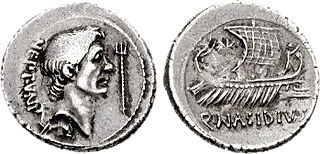Related Research Articles
The gens Afrania was a plebeian family at Rome, which is first mentioned in the second century BC. The first member of this gens to achieve prominence was Gaius Afranius Stellio, who became praetor in 185 BC.

The gens Farsuleia was an obscure plebeian family at ancient Rome, known chiefly from coins and inscriptions, dating from the final decades of the Republic and imperial times. None of its members held any of the higher magistracies of the Roman state.

The gens Nasidia was an obscure plebeian family at Rome. The gens is best known from Quintus Nasidius, one of the admirals of Gnaeus Pompeius Magnus during the Civil War. Although none of the Nasidii are known to have held any of the higher offices of the Roman state, a number are known from inscriptions. A coin of this gens depicts the head of Pompeius and a trident on the obverse, and on the reverse a ship, with the inscription Q. Nasidius.
The gens Numeria was a minor plebeian family at ancient Rome. Few of its members held any of the higher offices of the Roman state.
The gens Orbia was a minor plebeian family at Rome. No members of this gens are known to have held any magistracies, but many of them are known from inscriptions. The most illustrious of the family may have been the jurist Publius Orbius, a contemporary of Cicero.
The gens Orcivia, also written Orcevia and Orchivia, was a minor plebeian family at Rome. Few of them achieved any prominence in the Roman state, but many are known from inscriptions.
The gens Pescennia was a plebeian family at ancient Rome. Members of this gens are first mentioned in the time of Cicero, but it was not until imperial times that they came to prominence. The Pescennii were of equestrian rank. The most illustrious of the family was Gaius Pescennius Niger, an able general, who was proclaimed emperor in AD 193, only to be defeated and put to death by Septimius Severus the following year.
The gens Petreia was a minor plebeian family at ancient Rome. Members of this gens are first mentioned toward the end of the second century BC, and several were distinguished as soldiers, but none of them ever attained the consulship.
The gens Pleminia was a minor plebeian family at ancient Rome. The only member of this gens mentioned in history is Quintus Pleminius, infamous for his outrageous conduct at Locri during the Second Punic War. Other Pleminii are known from inscriptions.
The gens Pontilia was an obscure plebeian family at ancient Rome. Hardly any members of this gens appear in history, but a number of them are mentioned in inscriptions.
The gens Praecilia or Precilia, also written as Praecillia or Precillia, was an obscure plebeian family at ancient Rome. Few members of this gens are mentioned in history, but a number are known from inscriptions.
The gens Praeconia, occasionally written Preconia, was an obscure plebeian family at ancient Rome. No members of this gens are mentioned in history, but a few are known from inscriptions.
The gens Racilia was a minor plebeian family at ancient Rome. Members of this gens are mentioned as early as the fifth century BC, but few of them achieved any prominence in the Roman state.
The gens Rammia was an obscure plebeian family at ancient Rome. Members of this gens are first mentioned in the period leading to the Third Macedonian War, but no Rammius attained a position of importance in the Roman state until Quintus Rammius Martialis, governor of Egypt early in the second century AD.
The gens Romania was an obscure plebeian family at ancient Rome. No members of this gens appear in history, but many are known from inscriptions.
The gens Rusticelia, occasionally spelled Rusticellia, was an obscure plebeian family at ancient Rome. Hardly any members of this gens are mentioned in ancient writers, but a number are known from inscriptions.
The gens Selicia, possibly identical with Silicia, was an obscure plebeian family at ancient Rome. Hardly any members of this gens are mentioned in history, but a number are known from inscriptions.
The gens Silicia, possibly the same as Selicia, was an obscure plebeian family at ancient Rome. Hardly any members of this gens are mentioned in history, but a number are known from inscriptions, many of them from Roman Africa.
The gens Servenia was a minor plebeian family at ancient Rome. No members of this gens are mentioned in ancient writers, but a number are known from inscriptions, dating from the late Republic to the third century. At least some of the Servenii attained senatorial rank under the early Empire. None of them appear to have held the consulship, but Lucius Servenius Cornutus was praetor, and an important provincial governor under the Flavian dynasty.
The gens Servia was a minor plebeian family at ancient Rome. Few members of this gens are mentioned in ancient writers, but a number are known from inscriptions.
References
- ↑ Chase, pp. 118–120.
- ↑ New College Latin & English Dictionary, s.v. umbo.
- ↑ Chase, pp. 109, 110.
- ↑ Chase, pp. 112–114.
- 1 2 AE 1997, 737.
- ↑ AE 1988, 543.
- ↑ Tuck, Latin Inscriptions in the Kelsey Museum, 342.
- ↑ Cassius Dio, lx. 24.
- ↑ PIR, vol. III, p. 467 (V, No. 590).
- ↑ Silvestrini, Le tribù romane, p. 165.
- ↑ CIL IX, 1128.
- ↑ CIL VIII, 24642a.
- ↑ CIL VIII, 7068.
- ↑ CIL VIII, 3279.
- ↑ CIL VIII, 13162.
- ↑ CIL VI, 23147.